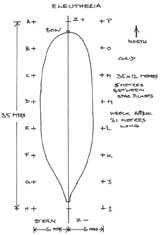Eleutheria
![]() Wreck Dive |
Wreck Dive | ![]() Boat access
Boat access
![]()
![]()
![]()
Wooden Hulk | Max Depth: 20 m (66 ft)
Do not dive near the Eleutheria without a permit. The shipwreck lies within a 250 metre radius protection zone for the City of Launceston. If you enter this zone severe penalties apply. Stay clear!
Level: Advanced Open Water and beyond.
The Eleutheria shipwreck lies near the City of Launceston shipwreck in Port Phillip. After trading around the world as a three-masted wooden barque, she was converted to powder hulk in 1862. The Eleutheria was later used as the base of operations for salvage attempts on the City of Launceston, during which she sank on 5 July 1866.
Diving the Eleutheria Shipwreck
This gets interesting. The Eleutheria lies 157 metres, bearing 227°, south-west of the City of Launceston. The site of the City of Launceston is a historic shipwreck protected zone with a 250 metre radius from:
Latitude: 38° 4.610′ S (38.076829° S / 38° 4′ 36.58″ S)
Longitude: 144° 49.579′ E (144.826321° E / 144° 49′ 34.76″ E)
.
As the Eleutheria lies within this protection zone, a permit from Heritage Victoria is required to dive the Eleutheria. Anchoring is prohibited.
The winter months offer the best visibility at the Eleutheria wreck, especially when the water temperature drops to around 10°C.
There is a great deal of the wreck exposed and a considerable number of objects throughout the site. Whilst the many iron knees and ships timbers are easy to identify, there are several large objects yet to be identified. There is a small steam engine or pump at the port bow, which is heavily encrusted.
A heavy wire cable lies across the wreck about amidships. This cable may be part of the salvage gear, or the remains of a scallop dredge cable.
Eleutheria Shipwreck History — Built in 1835
The Eleutheria was a three-masted wooden barque of 404 tons, built in 1835, launched on 23 January 1835, and completed on 24 January 1835, by Cuthbert Young & Son, at South Shields, Durham, United Kingdom. The dimensions of the vessel were 104.7 ft (32 m) in length, with a beam of 27.8 ft (8.47 m).
For about 20 years the Eleutheria traded around the world for various UK owners until late 1855. Voyages before coming to Australia included: London to Quebec, London to Londonerry to Bordeaux, Limerick to New York, and Liverpool to Barbados. The then barque arrived in Melbourne from Glasgow in 1854 with 21 passengers. She was advertised for sale while lying in Hobsons Bay. The Eleutheria was converted to a powder hulk in 1862.
On 14 November 1865, the Eleutheria was towed down Port Phillip with salvage equipment, divers and twenty men to the wreck site of the City of Launceston, where it was used as a floating platform, to set up salvage efforts on the sunken steamer.
Eleutheria Sinking — 5 July 1866
After a number of salvage attempts on City of Launceston, the Eleutheria was purchased by engineer Barrett, for £310 on 29 June 1866 and sold to a group of shareholders for a final salvage attempt, using the Eleutheria for lighterage, for which had been employed in previous salvage attempts. Used as base for operations, here it remained moored until 5 July 1866, when it was discovered to have sunk next to the wreck of the City of Launceston, with reportedly a lot of salvage gear on board. No efforts were made to salvage the Eleutheria.
Least depth of water over highest part of vessel is 7 fm (13 m).
See also, Heritage Council Victoria: Eleutheria, and
Australian National Shipwreck Database: Eleutheria.
Heritage Warning: Any shipwreck or shipwreck relic that is 75 years or older is protected by legislation. Other items of maritime heritage 75 years or older are also protected by legislation. Activities such as digging for bottles, coins or other artefacts that involve the disturbance of archaeological sites may be in breach of the legislation, and penalties may apply. The legislation requires the mandatory reporting to Heritage Victoria as soon as practicable of any archaeological site that is identified. See Maritime heritage. Anyone with information about looting or stolen artefacts should call Heritage Victoria on (03) 7022 6390, or send an email to [email protected].
Traditional Owners — This dive site does not lie in the acknowledged traditional Country of any first peoples of Australia.
Eleutheria Location Map
Latitude: 38° 4.667′ S (38.077778° S / 38° 4′ 40″ S)
Longitude: 144° 49.500′ E (144.825° E / 144° 49′ 30″ E)
Datum: WGS84 |
Google Map
Added: 2012-07-22 09:00:00 GMT, Last updated: 2022-05-11 03:43:14 GMT
Source: GPS
Nearest Neighbour: Pinafore, 140 m, bearing 258°, WSW
Three-Masted Wooden Barque.
Built: Shields, Durham, England, 1835.
Sunk: 5 July 1866.
Port Phillip.
Depth: 20 m.
[ Top ]
DISCLAIMER: No claim is made by The Scuba Doctor as to the accuracy of the dive site coordinates listed here. Should anyone decide to use these GPS marks to locate and dive on a site, they do so entirely at their own risk. Always verify against other sources.
The marks come from numerous sources including commercial operators, independent dive clubs, reference works, and active divers. Some are known to be accurate, while others may not be. Some GPS marks may even have come from maps using the AGD66 datum, and thus may need be converted to the WGS84 datum. To distinguish between the possible accuracy of the dive site marks, we've tried to give each mark a source of GPS, Google Earth, or unknown.


